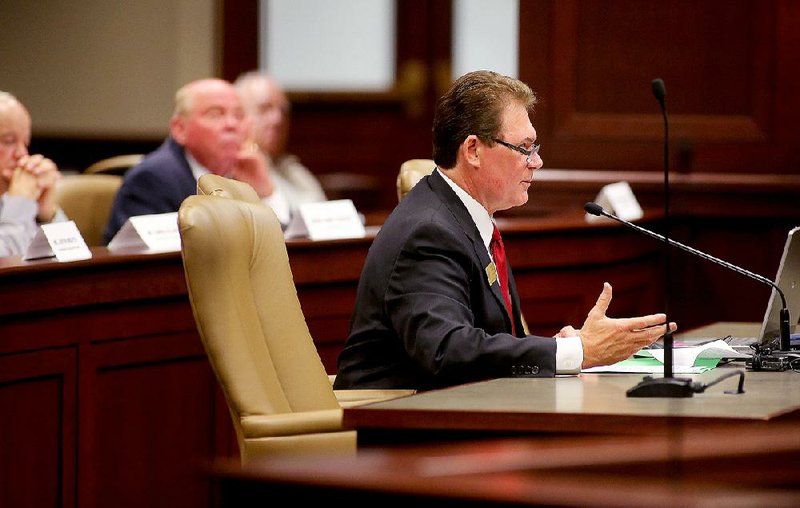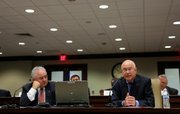The state Senate Insurance and Commerce Committee chairman, Jason Rapert, wants the Arkansas Legislature to convene and address problems with the state's largely unregulated levee system.
But Gov. Asa Hutchinson, who agrees that changes are needed, said the matter may be best handled in a regular legislative session.
At the end of a joint meeting of the state Senate and House's Insurance and Commerce committees and Agriculture, Forestry and Economic Development committees, Rapert, R-Bigelow, said there were concrete steps the state could take to document and assess the threats to Arkansas homes and property protected by an inconsistent "patchwork" of levees.
Rapert, whose property was severely damaged after a levee broke during flooding earlier this month, said that if Hutchinson calls lawmakers back for a special session, levees need to be on the agenda.
"I think that'd be the best thing to do, and we'd have it handled going into next season," Rapert said.
With the U.S. Supreme Court weighing a decision that could significantly alter the federal Patient Protection and Affordable Care Act and Arkansas' own private-option program, there has been much discussion among lawmakers about the possibility of a special session soon.
On Wednesday, Hutchinson said that though he's very concerned about the poor state of Arkansas' levees, the concern may not yet be ripe for legislative action.
"This is a matter that needs some serious study. It's a matter of neglect in our state, and it was reflected in the recent flooding, and we'll have problems again if we don't address it," Hutchinson said. "It is not a simple solution. It's a matter of organization, but it's also a funding issue. ... I'm not sure it will be ready in a short period of time, so we'll wait and see. This [matter] is a big lift. .... Let's wait and see how it develops."
At Wednesday's committee meeting, Randy Young, the head of the Arkansas Natural Resources Commission, said the recent flooding along the Arkansas, Red, and Little rivers showed that current oversight is insufficient.
"We don't know the number of them or where they are," Young said. "We don't have an agency in state government that has oversight or responsibility to address that problem."
The greater part of the state's flood protections were erected after the great flood of 1927 along the Mississippi River, which left thousands dead and tens of thousands homeless.
The U.S. Army Corps of Engineers spent the next several decades constructing flood levees throughout the state and then handed them over to locally run levee districts or "levee boards."
The boards are autonomous political entities that don't answer to state or local officials. Over time, many have dissolved, leaving an unknown number of levees unmonitored and, ultimately, at risk of being breached by floodwaters, according to federal officials.
Boards can levy taxes in a county for repairing levees, but as Rapert and other officials pointed out, there are several counties collecting taxes for nonexistent levee boards.
It's not clear how much Arkansas taxpayers are paying for levees or how the money is being used, Rapert said.
A U.S. Army Corps of Engineers program helps qualifying levee boards cover maintenance costs and makes nearby properties eligible for federal flood insurance, but those boards have to follow the Corps standards and be subjected to regular inspections.
But many of those levee districts, half in the Corps' Little Rock Division alone, are "inactive," according to Corps officials, meaning they are not up to code. Often, the Corps can't even determine who -- if anyone -- is in charge of a levee.
As a result, homeowners who think they are protected from flooding may be relying on a levee that hasn't been properly maintained for decades.
Perry County residents discovered problems with one of their levees earlier this month after a 150-yard segment failed. Built in 1910, it had been designated inactive in the federal program for several decades, with no one taking responsibility for its maintenance and upkeep.
After severe flooding in 2008, lawmakers requested an audit of the state's levee system. It showed there is no uniform standard for the state's levees, nor is there any mechanism for the state to try to repair abandoned levees or reconstitute levee boards.
The audit made several recommendations, including changing state law to allow the state Natural Resources Commission to compile a list of all the state's levees, develop statewide standards for maintenance and inspection for levees not participating in the federal program, and require levee boards to report more information to state officials.
Six years later, little has changed, Rapert said.
"Nothing else was enacted there that gave teeth to what they're doing," Rapert said. "We're here again in 2015, we've had another major flood. ... People have had to move out of their homes, businesses have been flooded, crops have been destroyed, and it all could have been been prevented if [lawmakers] would have just acted upon some of the simple steps put in place in the report."
Young of the Natural Resources Commission said current state law handcuffs his organization from doing much of anything with the state's levees.
"The first [priority] in my mind is identifying where all the levees are and the areas they're supposed to protect, particularly those [levees] that are not functioning," Young said. "The other is, we need the ability to establish a standard by which they are maintained."
Speaking with reporters later Wednesday, Hutchinson said he wants the state to play a greater role and provide oversight while also finding a way to rebuild levee districts and finding ways for them to strengthen the states' flood defenses.
"In one levee district, they were telling me the revenue stream is only sufficient to do the mowing on the levee and nothing more," Hutchinson said. "It's an inefficient, ineffective system we have in place now."
County Judge Larry Burgess, who saw the small Miller County town of Garland evacuate after officials spotted several sand boils developing at the nearby levee, echoed concerns of other county officials that whenever the floods hit, it is counties that bear the brunt of the work in recovery, yet they can have no say in their levees.
Burgess said that whatever happens in the future, there needs to be more communication and more oversight.
"There is no oversight. [Levee boards are] almost like a homeowners association. There's nothing I can do. I'm not in the loop," Burgess said. "Even if I knew about [levee problems], I can't make them fix anything."
Metro on 06/25/2015



